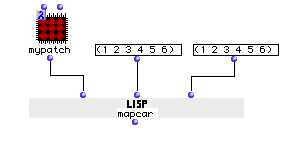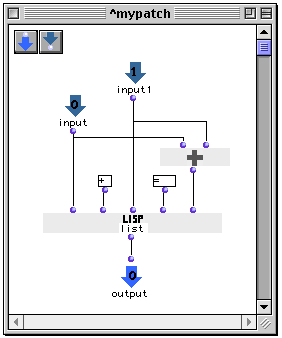OpenMusic Reference
mapcar

mapcar
(LISP function) -- returns the results of several evaluations of function as a list
Syntax
mapcar function list &restmore-lists
Inputs
| name | data type(s) | comments |
|---|---|---|
| function | symbol, function name or lambda function | the function that will be evaulated |
| list | a list or tree | A list of arguments for the first input of function |
| more-lists | a list or tree | repeatable; lists of arguments for additional inputs of function |
Output
| output | data type(s) | comments |
|---|---|---|
| first | a list or tree | the results of the evaluations |
Description
Calls function , passing it the first argument of list and more- lists , then calling it again, but passing the second element of list and more-lists , and so on, until the lists (or the shortest of the input lists, if they are not the same length) has been exhausted. The results of the series of function calls are collected in a list and returned.
function may be a symbol, a function name, or function in lambda mode. Note that if you pass a function in lambda mode with repeatable inputs, you must add the correct number to accomodate the number of arguments you are passing it at the other inputs. This is not necessary if the function name is entered directly instead of its icon in lambda mode.
mapcar is similar in operation to [_ funcall ](funcall), which also calls _function but only calls it once, passing all its arguments simultaneously. mapcar is also similar to mapcan , which iterates lists as arguments to function in the same way but returns the result as a single entity..
 |
LISP functions |
The basic LISP functions are too numerous to document comprehensively in this manual. As an aid to the neophyte, the most commonly used have been included in this documentation, but they represent a small fraction of the total functionality of the MCL environment. Numerous on-line resources exist, for instance the online version of Common Lisp the Language, 2nd Edition.
Examples
An “edcuational” example of mapcar

Here, the first elements in the two lists will be passed to patch mypatch ‘s two inputs, followed by the second elements of the two lists, and so on. Here’s what’s happening in mypatch :

The pairs are being made into lists together with the symbols + and = and their sums. The resulting lists will be collected for each pair of inputs:
? OM->((1 + 1 = 2) (2 + 2 = 4) (3 + 3 = 6) (4 + 4 = 8) (5 + 5 = 10) (6 + 6 = 12))
| Prev | Home | Next |
|---|---|---|
| mapcan | Up | maquette2obj |